
An electric light, lamp, or light bulb is an electrical component that produces light. It is the most common form of artificial lighting. Lamps usually have a base made of ceramic, metal, glass, or plastic, which secures the lamp in the socket of a light fixture, which is often called a "lamp" as well. The electrical connection to the socket may be made with a screw-thread base, two metal pins, two metal caps or a bayonet mount.
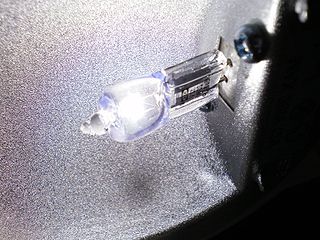
A halogen lamp is an incandescent lamp consisting of a tungsten filament sealed in a compact transparent envelope that is filled with a mixture of an inert gas and a small amount of a halogen, such as iodine or bromine. The combination of the halogen gas and the tungsten filament produces a halogen-cycle chemical reaction, which redeposits evaporated tungsten on the filament, increasing its life and maintaining the clarity of the envelope. This allows the filament to operate at a higher temperature than a standard incandescent lamp of similar power and operating life; this also produces light with higher luminous efficacy and color temperature. The small size of halogen lamps permits their use in compact optical systems for projectors and illumination. The small glass envelope may be enclosed in a much larger outer glass bulb, which has a lower temperature, protects the inner bulb from contamination, and makes the bulb mechanically more similar to a conventional lamp.

A fluorescent lamp, or fluorescent tube, is a low-pressure mercury-vapor gas-discharge lamp that uses fluorescence to produce visible light. An electric current in the gas excites mercury vapor, which produces short-wave ultraviolet light that then causes a phosphor coating on the inside of the lamp to glow. A fluorescent lamp converts electrical energy into useful light much more efficiently than an incandescent lamp. The typical luminous efficacy of fluorescent lighting systems is 50–100 lumens per watt, several times the efficacy of incandescent bulbs with comparable light output. For comparison, the luminous efficacy of an incandescent bulb may only be 16 lumens per watt.

Lighting or illumination is the deliberate use of light to achieve practical or aesthetic effects. Lighting includes the use of both artificial light sources like lamps and light fixtures, as well as natural illumination by capturing daylight. Daylighting is sometimes used as the main source of light during daytime in buildings. This can save energy in place of using artificial lighting, which represents a major component of energy consumption in buildings. Proper lighting can enhance task performance, improve the appearance of an area, or have positive psychological effects on occupants.

A flashlight (US), or torch (CE) is a portable hand-held electric lamp. Formerly, the light source typically was a miniature incandescent light bulb, but these have been displaced by light-emitting diodes (LEDs) since the early 2000s. A typical flashlight consists of the light source mounted in a reflector, a transparent cover to protect the light source and reflector, a battery, and a switch, all enclosed in a case.

Electrical wiring is an electrical installation of cabling and associated devices such as switches, distribution boards, sockets, and light fittings in a structure.

A compact fluorescent lamp (CFL), also called compact fluorescent light, energy-saving light and compact fluorescent tube, is a fluorescent lamp designed to replace an incandescent light bulb; some types fit into light fixtures designed for incandescent bulbs. The lamps use a tube that is curved or folded to fit into the space of an incandescent bulb, and a compact electronic ballast in the base of the lamp.
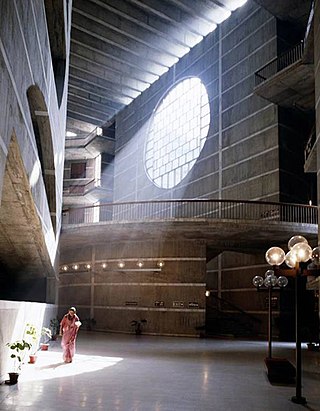
Architectural lighting design is a field of work or study that is concerned with the design of lighting systems within the built environment, both interior and exterior. It can include manipulation and design of both daylight and electric light or both, to serve human needs.

A light fixture, light fitting, lamp, or luminaire is an electrical device containing an electrical component called a lamp that provides illumination. All light fixtures have a fixture body and one or more lamps. The lamps may be in sockets for easy replacement—or, in the case of some LED fixtures, hard-wired in place.

A test light, test lamp, voltage tester, or mains tester is a piece of electronic test equipment used to determine the presence of electricity in a piece of equipment under test. A test light is simpler and less costly than a measuring instrument such as a multimeter, and often suffices for checking for the presence of voltage on a conductor. Properly designed test lights include features to protect the user from accidental electric shock. Non-contact test lights can detect voltage on insulated conductors.

Landscape lighting or garden lighting refers to the use of outdoor illumination of private gardens and public landscapes; for the enhancement and purposes of safety, nighttime aesthetics, accessibility, security, recreation and sports, and social and event uses.

A lighting control system incorporates communication between various system inputs and outputs related to lighting control with the use of one or more central computing devices. Lighting control systems are widely used on both indoor and outdoor lighting of commercial, industrial, and residential spaces. Lighting control systems are sometimes referred to under the term smart lighting. Lighting control systems serve to provide the right amount of light where and when it is needed.

A multifaceted reflector light bulb is a reflector housing format for halogen as well as some LED and fluorescent lamps. MR lamps were originally designed for use in slide projectors, but see use in residential lighting and retail lighting as well. They are suited to applications that require directional lighting such as track lighting, recessed ceiling lights, desk lamps, pendant fixtures, landscape lighting, retail display lighting, and bicycle headlights. MR lamps are designated by symbols such as MR16 where the diameter is represented by numerals indicating units of eighths of an inch. Common sizes for general lighting are MR16 and MR11, with MR20 and MR8 used in specialty applications. Many run on low voltage rather than mains voltage alternating current so require a power supply.

Track lighting is a method of lighting where light fixtures are attached anywhere on a continuous track device which contains electrical conductors. This is in contrast to directly routing electrical wiring to individual light positions. Tracks can either be mounted to ceilings or walls, lengthwise down beams, or crosswise across rafters or joists. They can also be hung with rods from especially high places like vaulted ceilings.

An LED lamp or LED light is an electric light that produces light using light-emitting diodes (LEDs). LED lamps are significantly more energy-efficient than equivalent incandescent lamps and can be significantly more than most fluorescent lamps. The most efficient commercially available LED lamps have efficiencies exceeding 200 lumens per watt (lm/W) and convert more than half the input power into light. Commercial LED lamps have a lifespan several times longer than both incandescent and fluorescent lamps.
United States Lighting Energy Policy is moving towards increased efficiency in order to lower greenhouse gas emissions and energy use. Lighting efficiency improvements in the United States can be seen through different standards and acts. The Energy Independence and Security Act of 2007 laid out changes in lighting legislation for the United States. This set up performance standards and the phase-out of incandescent light bulbs in order to require the use of more efficient fluorescent lighting. EISA 2007 is an effort to increase lighting efficiency by 25-30%. Opposition to EISA 2007 is demonstrated by the Better Use of Light Bulbs Act and the Light Bulb Freedom of Choice Act. The efforts to increase lighting efficiency are also demonstrated by the Energy Star program and the increase efficiency goals by 2011 and 2013. A ban on the manufacture and sale of most general purpose incandescent bulbs in the U.S. took effect on August 1, 2023.
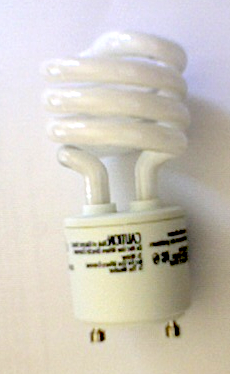
A GU24 lamp fitting is a bi-pin connector for compact fluorescent lamps (CFL) or LED lamps that uses a bayonet mount–like twist-lock bi-pin connector instead of the Edison screw fitting used on many CFLs, LED lamps and incandescent light bulbs. The design was initiated by the U.S. EPA and the Lighting Research Center in 2004, in order to facilitate the deployment of compact fluorescent light bulbs with replaceable ballasts.
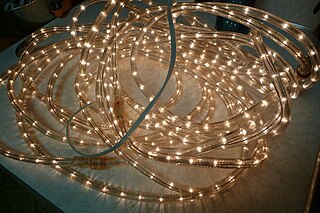
A rope light is primarily used as a decorative lighting fixture, featuring small lights linked together and encased in a PVC jacket to create a string of lights. Rope lights can be used in many applications both indoors and outdoors. Used in place of neon signs, it is sometimes called soft neon.

A recessed light or downlight is a light fixture that is installed into a hollow opening in a ceiling. When installed it appears to have light shining from a hole in the ceiling, concentrating the light in a downward direction as a broad floodlight or narrow spotlight.
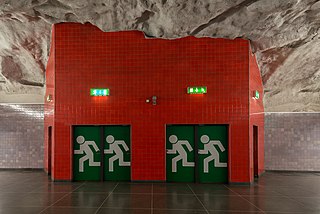
An exit sign is a pictogram or short text in a public facility denoting the location of the closest emergency exit to be used in case of fire or other emergency that requires rapid evacuation. Most relevant codes require exit signs to be permanently lit at all times.





















